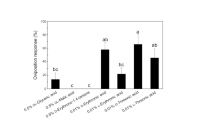Abstract
Peachtree borer (PTB) cocoons, peach tree bark, and a mixture of frass and gum obtained arount PTB wounds were extracted with organic solvents of increasing polarity. Female PTB moths,Synanthedon exitiosa (Say), laid the greatest number of eggs on filter paper substrates treated with acetone extracts of PTB cocoons, ethyl acetate extracts of peach tree bark and acetone extracts of frass and gum mixtures. The extracts of cocoons or frass and gum mixture were separated by liquid chromatography and thin layer chromatography.
Similar content being viewed by others
References
Frankenhuyzen, A. van, 1978.Synanthedon myopaeformis (Borkhausen) in Nederland (Lepidoptera, Sesiidae).Entomol Ber. 38(1.VIII):119–123.
Frankenhuyzen, A. van, andWunen, T. 1979. Een nieuwe Vangmethode voorSynanthedon myopaeformis (Borkhausen) (Lep., Sesiidae).Entomol. Ber. 39(1.XI):164–167.
Gentry, C.R. 1981. Peachtree borer (Lepidoptera: Sesiidae): Control by mass trapping with synthetic sex pheromone. Misc. Publications,Entomol. Soc. Am. 12(2):98 pp.
Hudson, A., andMcLintock, J. 1967. A chemical factor that stimulates oviposition byCulex tarsalis Coquillet (Diptera, Culicidae).Anim. Behav. 15:336–341.
McLaughlin, J.R., Doolittle, R.E., Gentry, C.R., Mitchell, E.R., andTumlinson, J.H. 1975. Response to pheromone traps and disruption of pheromone communication in the lesser peachtree borer and the peachtree borer (Lepidoptera: Sesiidae).J. Chem. Ecol. 2:73–81.
Norris, M.J. 1963. Laboratory experiments on gregarious behavior in ovipositing females of the desert locust. (Schistocerca gregaria [Forsk]).Entomol. Exp. Appl. 6:279–303.
Pearson, R.C. andWieres, R.W. 1978. Pest problems associated with the decline of peach trees in the Hudson Valley of New York.Search Agric., (Geneva, NY) 8(4):000.
Snapp, O.I. andThomson, J.R. 1943. Life history and habits of the peachtree borer in the southeastern states.USDA Tech. Bull. 854.
Tumlinson, J.H., Yonce, C.E., Doolittle, R.E., Heath, R.R., Gentry, C.R., andMitchell, E.R. 1974. Sex pheromones and reproductive isolation of the lesser peachtree borer and the peachtree borer.Science 185:614–616.
Author information
Authors and Affiliations
Additional information
Synanthedon exitiosa (Say).
Mention of a commercial or proprietory product does not constitute an endorsement of this product by the USDA.
Rights and permissions
About this article
Cite this article
Gentry, C.R., Wells, J.M. Evidence of an oviposition stimulant for peachtree borer. J Chem Ecol 8, 1125–1132 (1982). https://doi.org/10.1007/BF00986983
Received:
Revised:
Issue Date:
DOI: https://doi.org/10.1007/BF00986983




